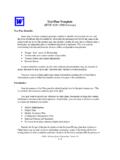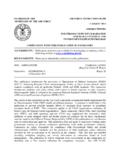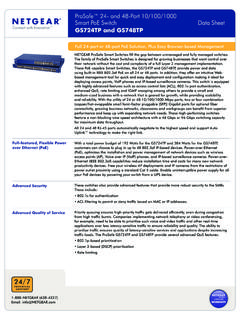Transcription of Operating Reserve Determination Evolution in Wind …
1 1 Abstract--The growth of wind power as an electrical power generation resource has produced great benefits with reductions in emissions and the supply of zero cost fuel. It also has created challenges for the operation of power systems arising from the increased variability and uncertainty it has introduced. A number of studies have been performed over the past decade to analyze the operational impacts that can occur at high penetrations of wind. One of the most crucial impacts is the amount of incremental Operating reserves required due to the variability and uncertainty of wind generation. This paper describes different assumptions and methods utilized to calculate the amount of different types of reserves carried, and how these methods have evolved as more studies have been performed. Index Terms-- Operating reserves, power system operation, power system reliability, power systems, wind power generation I.
2 INTRODUCTION IND power has seen rapid growth in the past decade. Its zero-cost fuel and emissions-free output provide great benefits to consumers and society. Utility-scale wind is a new resource and is increasing at such a rapid rate that utilities and system operators are becoming concerned about the integration issues and costs that it introduces. Wind power integration studies have been performed by numerous entities to help understand and quantify these impacts [1], [2]. The studies typically simulate a future power system with high wind penetrations, and evaluate the impacts on the grid and the incremental Operating costs that result [3]. These studies have been maturing continuously as the state of the art advances, with each study generally building on previous studies. Some of these studies have compared the costs and operational differences between a system with high wind penetration and a system that does not bring the incremental variability and uncertainty that wind presents.
3 The additional costs generally occur because the unit commitment is inefficient due to forecast errors and because it is adjusted to provide more flexibility, accommodating wind s increased variability and uncertainty. Additional flexibility can be in the form of increased ramp rates, decreased minimum generation limits, and increased amounts of Operating Reserve . Noting that E. Ela and M. Milligan are with the National Renewable Energy Laboratory (email: E. Lannoye, D. Flynn, and M. O Malley are with the University College Dublin (email: B. Kirby is a private consultant (email: B. Zavadil is with Enernex Corporation (email: these are studies and that the results should be realized as such, much controversy often occurs over these costs due to the many assumptions that are required to be made. For example, wind forecasts used in the study are usually based on a model of how a forecast may be produced some time in the future (looking at a past weather year).))))
4 Since predicting the actual output of the wind resource from a model is a difficult task in itself, predicting what the forecast error may be can add more uncertainty to the results. Secondly, the Determination of Operating reserves has been analyzed using many different methodologies and can differ significantly from study to study. Operating reserves are subject to many different naming conventions in different regions throughout the world. This paper defines Operating Reserve as the real power capacity that can be called on at any instance of imbalance between generation and Most wind power integration studies run hourly simulations of bulk power system operations for a particular study area, and therefore the actual utilization of the designated Operating Reserve capacity is not in fact realized in detail. Therefore, Operating Reserve requirements are determined statistically, but usually not validated in simulations.
5 Two important objectives that often form part of these studies are the costs or savings of integrating additional wind power and the operational changes that are recommended at high penetrations of wind power. Many of the studies recommend the use of incremental Operating reserves, which will also affect the total costs. This makes the assumptions used in the methodology to assess Operating Reserve a very important component of the overall study. Many areas will adopt these methodologies from the studies as wind penetrations increase and therefore it is additionally important for actual system operations in the future. This paper will focus on methods of determining Operating reserves for power systems with high penetrations of wind power. Section II will describe current practices and definitions of Operating reserves in North America, mainland Europe, and Ireland.
6 Section III will cover some recent wind power integration studies that have been performed, and will focus on the methods used in each study when calculating the Operating Reserve requirements. In section IV, the authors will provide insight into the strengths of different methods, including analysis on how the Operating Reserve Determination problem may change in wind power integration studies and in actual system operations. Section V concludes the discussion. 1 Additionally, Operating reserves or ancillary services can include voltage or reactive power support as well as black start service. Evolution of Operating Reserve Determination in Wind Power Integration Studies Erik Ela, Member, IEEE, Brendan Kirby, Senior Member, IEEE, Eamonn Lannoye, Student Member, IEEE, Michael Milligan, Member, IEEE, Damian Flynn, Member, IEEE, Bob Zavadil, Member, IEEE Mark O Malley, Fellow IEEE W 2 II.
7 Operating Reserve DEFINITIONS AND STANDARDS Variability and uncertainty are not unique to wind generation: similar characteristics in aggregate electric demand and even supply resources have always posed challenges for power system operators. Future loads cannot be perfectly predicted, loads and generator outputs can vary substantially in different time frames, and large power system equipment can fail at any given time without notice. Power system operators secure different amounts and types of Operating reserves to compensate for these characteristics in order to serve load reliably and maintain the system frequency. There are many different definitions and rules concerning what Operating reserves entail. For example, the North American Electric Reliability Corporation (NERC) defines Operating reserves as the following: That capability above firm system demand required to provide for regulation, load forecasting error, equipment forced and scheduled outages and local area protection.
8 It consists of spinning and non-spinning Reserve . [4] In most of North America, these reserves can be further placed in three categories: Spinning Reserve The portion of Operating Reserve consisting of: Generation synchronized to the system and fully available to serve load within the Disturbance Recovery Period following the contingency event; or Load fully removable from the system within the Disturbance Recovery Period following the contingency event. Supplemental Reserve The portion of Operating Reserve consisting of: Generation (synchronized or capable of being synchronized) that is fully available to serve load within the Disturbance Recovery Period following the contingency event; or Load fully removable from the system within the Disturbance Recovery Period following the contingency event. Regulating Reserve An amount of Reserve responsive to Automatic Generation Control which is sufficient to provide normal regulating margin.
9 Further definitions can separate the second category by response time and response sustainability. In North America, the spinning Reserve and supplemental Reserve described above are often combined and referred to as contingency Reserve , only being used for instances of generator or network contingency events. Though contrary to the NERC definition of Operating Reserve described above, regulating Reserve is generally procured in both the upward and downward directions ( in cases of over-generation). Fast frequency response (governor response) is not yet explicitly addressed by NERC as a distinct Operating Reserve , but the Western Electricity Coordinating Council (WECC) has started to study the need for a 30 second response: frequency responsive Reserve (FRR). Transmission also impacts the need for Operating reserves, since it can provide access to additional Reserve supplies and reduce the overall need for reserves by increasing the Reserve sharing pool.
10 Limited transmission may also mean more localized Reserve requirements. Transmission lines may be operated at levels below their maximum capacities to account for other transmission contingencies, similar to generator Operating Reserve . Other standards and policies detail how much a balancing area will require of each type of Operating Reserve [4]. For instance, the NERC BAL-002 standard requires that a balancing authority or Reserve sharing group maintain at least enough contingency Reserve to cover the most severe single contingency. For the western interconnection, this is extended by a proposal by WECC to state that the minimum amount of contingency Reserve should be the greater of the most severe single contingency or the sum of 3% of the balancing area load and 3% of the balancing area generation. Detailed specifications of contingency Reserve requirements, including the amount of spinning compared to supplemental Reserve , are established by each Regional Reliability Organization.





